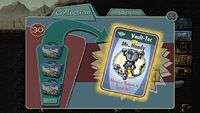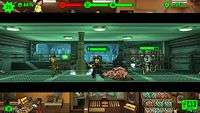Fallout Shelter – Review
by Mark R
 When you think of Bethesda, assuming you ignore the fact that most of their releases are bug-ridden prior to being patched countless times, you will hopefully think about immersion. They’re known for games where the tiniest nooks and crannies can contain so much lore and exposition that it puts others to shame, and many of the stories within the Elder Scrolls and Fallout series only become clear if you have keen observation skills and spend the time piecing them together. Imagine, then, the possibilities when these story-weavers turn their attention to the mobile market – an immersive game that you can carry with you wherever you go.
When you think of Bethesda, assuming you ignore the fact that most of their releases are bug-ridden prior to being patched countless times, you will hopefully think about immersion. They’re known for games where the tiniest nooks and crannies can contain so much lore and exposition that it puts others to shame, and many of the stories within the Elder Scrolls and Fallout series only become clear if you have keen observation skills and spend the time piecing them together. Imagine, then, the possibilities when these story-weavers turn their attention to the mobile market – an immersive game that you can carry with you wherever you go.
Sadly, for whatever reason, the Fallout mobile game that had been bandied about since 2009 hasn’t developed into anything of real worth. It’s a pretty standard resource management game, where the premise is that you take on the role of Overseer within your own vault. Aesthetically, there are immediate signs of their influence from the recent XCOM‘s ant-farm base mechanic where you expand deep into the ground using elevators to access each floor. With the rooms themselves being rendered in 3D while each character remains strictly two-dimensional, the overall look and feel works well and sticks pretty close to what we’d expect from the Fallout universe – retro-futuristic with a little bit of kitsch thrown in.
The build menu brings up a slider where all available room types are on display, and your ability to place them is determined only by the number of caps you possess and whether you’ve welcomed enough dwellers into your vault to unlock that particular room. In the beginning, it’s all about the resources themselves as you can’t realistically build a secured living environment for your people if there’s no power, a lack of food, and the drinking water gives them slow-trickling radiation poisoning. Your first task is therefore to generate electricity, purify water, and provide nourishment to these poor souls.
 In a clever move by Bethesda, which I either skipped entirely through impatience or which wasn’t explained at all during the tutorial, each room type has a specific S.P.E.C.I.A.L attribute assigned to it in order to help it produce at a faster rate. The radio station, for example, utilises the Charisma trait and so placing dwellers with higher-level charisma will entice new residents quicker than if you were to fill it with those whose speciality fell within the Intelligence or Strength area. Expanding each room by a further two blocks allows you to have a larger team working together, and the option is also there to upgrade the rooms themselves to increase overall output and increase their storage ability.
In a clever move by Bethesda, which I either skipped entirely through impatience or which wasn’t explained at all during the tutorial, each room type has a specific S.P.E.C.I.A.L attribute assigned to it in order to help it produce at a faster rate. The radio station, for example, utilises the Charisma trait and so placing dwellers with higher-level charisma will entice new residents quicker than if you were to fill it with those whose speciality fell within the Intelligence or Strength area. Expanding each room by a further two blocks allows you to have a larger team working together, and the option is also there to upgrade the rooms themselves to increase overall output and increase their storage ability.
Each room’s resources count down to zero, and the time it takes for this is determined by how many upgrades have been applied, how many workers have been assigned, and what their individual (and thereby combined) S.P.E.C.I.A.L stats are. Once the counter reaches zero, the room is highlighted in green along with an icon to show that the resources are ready to be collected. If you don’t collect the resources, the workers can’t get back to work and so you’ll hit a stalemate where your base has needs which can’t be fulfilled because you’re not paying attention.
 |
 |
 |
 |
 |
 |
At the start, your electricity comes from a basic Power Generator room, food from the Diner, and drink comes through a Water Treatment plant. As you attract more dwellers and unlock more rooms you’ll be able to produce the same resources much quicker, and in greater volume, by building the Nuclear Reactor, Garden, and Water Purification plant respectively. Should you stick with Fallout Shelter long enough to entice one hundred wasteland wanderers to take up residence, you’ll unlock the final room – the Nuka-Cola Bottler, which produces food and drink at the same time.
 While it would make sense to demolish any existing food or drink-producing rooms and replace them with the Nuka-Cola Bottler, this can only be done if they are at either end of their floor or don’t act as a thoroughfare to any other rooms. This can be a pretty bitter pill to swallow because, once those pesky deathclaws start to attack your vault, you’ll wish (like I do) that you’d expanded the living quarters on the top level beyond the single-room that your vault came with, and filled it with heavily-armoured, kitted-out high-level characters. The temptation is still there to upgrade that particular room, but doing so would mean demolishing the adjoining diner, water treatment room, and medbay.
While it would make sense to demolish any existing food or drink-producing rooms and replace them with the Nuka-Cola Bottler, this can only be done if they are at either end of their floor or don’t act as a thoroughfare to any other rooms. This can be a pretty bitter pill to swallow because, once those pesky deathclaws start to attack your vault, you’ll wish (like I do) that you’d expanded the living quarters on the top level beyond the single-room that your vault came with, and filled it with heavily-armoured, kitted-out high-level characters. The temptation is still there to upgrade that particular room, but doing so would mean demolishing the adjoining diner, water treatment room, and medbay.
If you feel like shaking things up a little, you can gear-up some of your dwellers and send them out into the wasteland to explore. The higher their level, and the better weaponry and armour they take, the greater the rewards will be. At first it’ll be a little slow, with the odd molerat or radroach here and there, but after a while you’ll start to see your explorer battle mirelurks, yao guai, and even Enclave deathclaws, as well as pick up all manner of clothing and weaponry. Their detailed journals allow you to follow their every move and thought, and it can be witty at times, especially when your beast of a man is hankering after some new shoes as his feet are aching. However long your explorer has been out, it’ll take them half as long again to return to the vault but if you don’t have enough storage space available there’s not much point in bringing them back.
For every little thing you do, there are in-game rewards, and what you’re awarded with will depend on the complexity of the objective. If you’re lucky enough, you’ll be given a Vault-Tec Lunch Box rather than caps. Each lunch box contains four cards, all randomly assigned, and turning them over reveals your new item – this could be cash, Stimpaks, RadAway, clothing, weaponry, or even a new dweller. Within these lunch boxes is the chance to uncover legendary items, but they’re given away so infrequently that you may want to resort to parting with real-world cash to buy a stash for later use. You can also buy your very own Mr Handy and assign him to any floor within your vault, which he’ll then patrol automatically, collecting resources as he goes.
 Beyond maintaining the required amount of power, food, and clean water for your dwellers, there’s really not a lot more to be said about Fallout Shelter. If a male and female hit it off they can get jiggy with it behind closed doors and produce their own baby dweller. If raiders or deathclaws tear their way in and kill some of the residents you can revive them by spending caps. If you’re looking for a comparison to be drawn, the best example I can give you is that Fallout Shelter is a Bethesda-produced mobile version of Animal Crossing – you spend ages setting everything up exactly how you want it, and then there’s nothing more than maintaining the balance for all eternity with literally no progress whatsoever.
Beyond maintaining the required amount of power, food, and clean water for your dwellers, there’s really not a lot more to be said about Fallout Shelter. If a male and female hit it off they can get jiggy with it behind closed doors and produce their own baby dweller. If raiders or deathclaws tear their way in and kill some of the residents you can revive them by spending caps. If you’re looking for a comparison to be drawn, the best example I can give you is that Fallout Shelter is a Bethesda-produced mobile version of Animal Crossing – you spend ages setting everything up exactly how you want it, and then there’s nothing more than maintaining the balance for all eternity with literally no progress whatsoever.
Sure, your dwellers will level up, you’ll eventually run out of available space, and you’ll still be able to build up additional caps… but to what end? Breaking it down into its simplest form, as enjoyable as it can be at the time, Fallout Shelter is ultimately a constant click-fest where your eyes will be constantly darting across the screen as you tap on dweller after dweller to accept their level-up status, clicking on rooms to collect resources, hitting the various on-screen notifications which let you know you’ve completed an in-game objective, and popping into the inventory menu every now and again to sell anything that you have multiples of in order to make room… for more multiples.
 |
 |
 |
 |
 |
 |
Initially, it’s fun. It looks great, performs well, and is simple as hell to pick up. For those of us champing at the bit for Fallout 4, it’s a quirky little distraction which can easily fill in some time for a few days but, ultimately, there’ll likely come a point where the shine wears off and you realise you’re stuck in a continuous loop where you’re tapping the screen in order to collect statistics. In fact, the only ones who have any real fun within the game and who aren’t tied to menial tasks 24/7 are those who wander off to explore the wasteland and are, essentially, within the same sort of rabbit hole that the The Sims games also suffered. What they encounter is interesting, witty, intriguing at times, and yet it all takes place outside of the vault, rendering your focal point useless.
Pros- Looks great and scales well on high-res tablets
- The familiar Fallout art style is shown in its full glory
- Very easy to pick up and play
- The collecting aspect plays into the inventory-hogging side of many Fallout players
- Lots of familiar names and faces
- The exploration journals offer a lot of entertainment after they've been out of the vault a considerable amount of time
- There's really not much to it
- After a while, gameplay is nothing more than continually clicking on notifications
- Loses its shine very quickly
Even though it's been on the cards for close to six years now, Bethesda haven't really produced something worthy of the time they've spent brainstorming their first foray into the mobile market. While it looks great and, on the surface, plays well, Fallout Shelter very quickly becomes nothing more than a screen-tapping grind with no real end in sight.
The familiar pointlessness of Animal Crossing, where the longevity is a mere extension of the need to maintain rather than progress, becomes apparent very early on and it then becomes a choice between continuing to sustain this level of dedication or accept that you could end up tapping your screen until 2077. Good fun for a few days, but nothing more.
Last five articles by Mark R
- From Acorns to Fish
- Alone In The Dark
- Why Borderlands is Better Than Borderlands 2
- Falling Short
- The Division: A Guide to Surviving the Dark Zone Solo


























There are no comments, yet.
Why don’t you be the first? Come on, you know you want to!